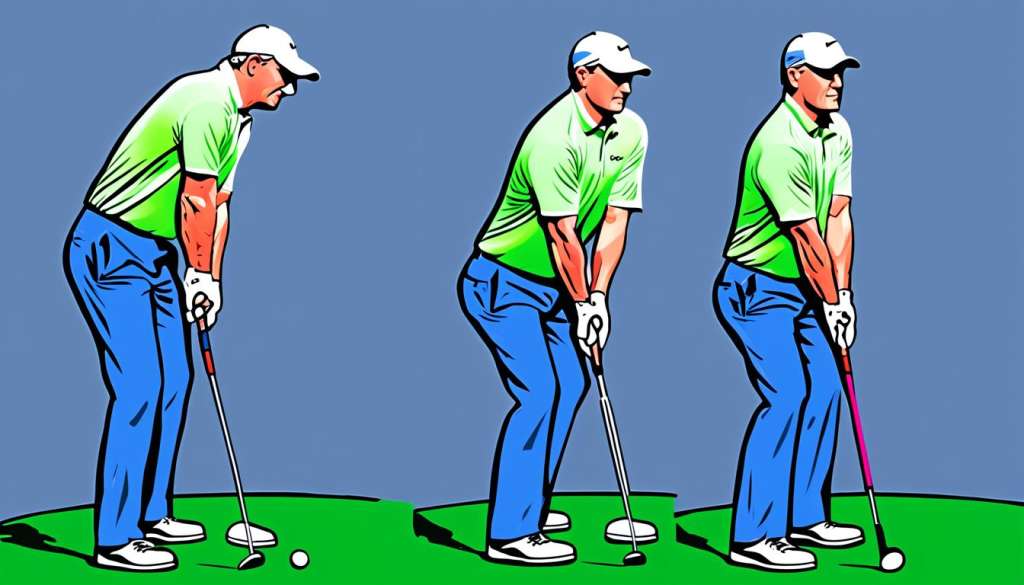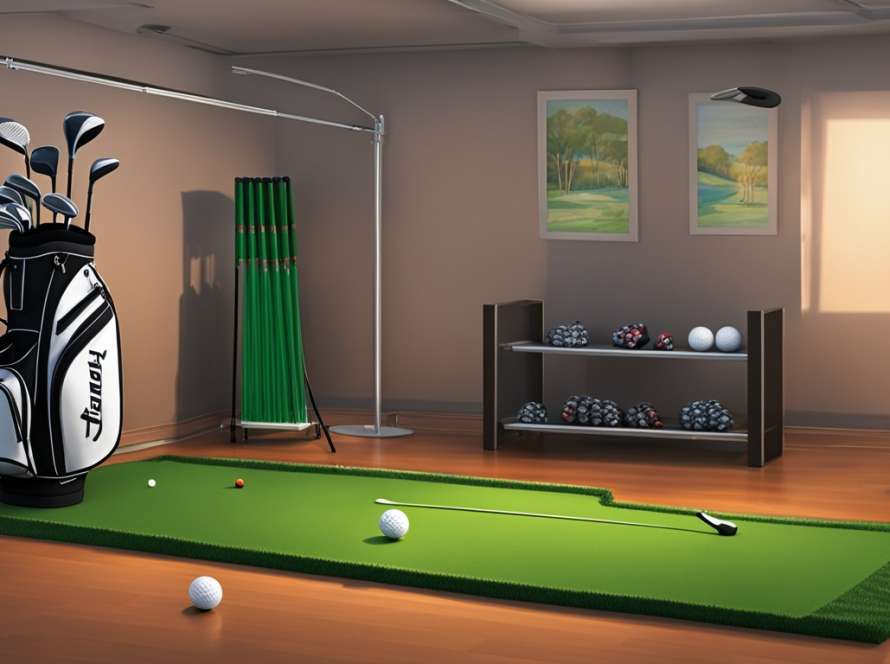Having flexibility in your golf swing is key to improving your game. A flexible body lets you move more freely, which means more power and accuracy in your shots. This guide will show you why flexibility matters and how to get it.
Golf swing flexibility is not just about touching your toes. It’s about moving many muscles and joints together. By working on your golf swing range of motion, you’ll boost your performance on the course.
A life spent sitting can make your golf game worse by reducing muscle flexibility and strength. Golf-specific stretching exercises can keep your muscles long and improve your swing. This guide will highlight the main areas to focus on for better flexibility in your golf swing.
Understanding the Importance of Flexibility in Golf
Flexibility is key in golf. It lets your body move fully, making your swing more powerful and accurate. Let’s see why it’s important and how it can boost your game.
The Role of Flexibility in a Dynamic Golf Swing
Your golf swing moves in different planes. Golf exercises make sure you rotate and extend well. Adding flexible tips to your routine will improve your swing.
How Flexibility Impacts Power and Accuracy
Being flexible means you can swing harder and hit more accurately. A full body rotation gives you more clubhead speed. This means longer drives and better iron shots. Drills for golf swing flexibility can help you reach this level.
Common Flexibility Issues Among Golfers
Many golfers have tight muscles and limited movement. Common issues include:
- Hip flexors
- Shoulder mobility
- Spine rotation
Working on these areas with golf exercises can greatly improve your swing. You’ll get a fuller backswing, better rotation, and faster clubhead speed.
| Flexibility Issue | Impact on Swing | Improvement Strategy |
|---|---|---|
| Tight hip flexors | Limited hip turn | Hip stretches and mobility drills |
| Restricted shoulder mobility | Shorter backswing | Shoulder rotations and stretches |
| Reduced spine rotation | Inconsistent ball striking | Torso twists and core exercises |
Adding these tips and exercises to your routine will make your swing smoother, stronger, and more accurate. Remember, being consistent is important. Make these drills a regular part of your golf practice.
Key Muscle Groups for a Flexible Golf Swing
To make your golf swing more flexible, focus on certain muscle groups. Knowing these areas helps you stretch better for golf. Let’s look at the key muscles that make your swing fluid and powerful.
Your core muscles are key for your golf swing. They help transfer power and keep your body stable. Having strong abs and obliques means better rotation and control in your swing.
Your glutes and hips are key for speed in your swing. Flexible hips help with rotation, and strong glutes keep your pelvis stable. This mix is vital for a smooth, strong swing.
Don’t forget about your leg muscles. Your quads and hamstrings help with stability and drive. When these muscles are flexible, you can move your legs better and transfer your weight during the swing.
Having a flexible upper body is also important for moving fully. Work on your shoulders and wrists for a full backswing and follow-through. Flexible shoulders mean a wider swing arc, and wrists that can control the club better.
| Muscle Group | Function in Golf Swing | Stretches for Flexibility |
|---|---|---|
| Core | Power transfer and stabilization | Torso twists, planks |
| Glutes and Hips | Rotation and power generation | Hip rotators, pigeon pose |
| Quadriceps and Hamstrings | Stability and leg drive | Standing quad stretch, seated hamstring stretch |
| Shoulders and Wrists | Full range of motion in swing | Arm circles, wrist flexor stretches |
Stretching these muscle groups will help you improve your golf swing flexibility. This will also boost your performance on the course.
The Impact of a Sedentary Lifestyle on Golf Performance
Working at a desk can hurt your golf swing flexibility. Sitting for long hours makes your muscles tight and less mobile, which affects your game. Let’s look at how sitting impacts your golf performance and what you can do to fix it.
How Sitting Affects Muscle Flexibility and Strength
Sitting for a long time makes muscles shorter and weaker. This is especially true for your hip flexors, hamstrings, and lower back muscles. These muscles are key for a flexible golf swing. When they get tight, you can’t move as much during your swing.
This means you’ll hit the ball with less power and accuracy. Your shots won’t be as good.
Combating the Effects of a Desk Job on Your Golf Game
To keep your golf swing flexible and enjoy the benefits of a flexible swing, try these tips:
- Take regular breaks to stretch and move
- Use a standing desk or balance ball chair
- Perform desk exercises like seated twists and leg lifts
- Incorporate a daily stretching routine focusing on hip mobility and core strength
- Schedule time for strength training exercises that target golf-specific muscles
By following these tips, you can fight the bad effects of sitting and boost your golf game. A flexible body means a more fluid, powerful swing and a better game overall.
Flexibility In Golf Swing Guide: Essential Stretches
Improving your golf swing flexibility is key to doing better on the course. This guide shows you important stretches and exercises. They help increase your flexibility and mobility for a smoother and stronger swing.
Pre-round Warm-up Exercises
Before you start playing, warm up with some mobility exercises. Begin with a 5-minute jog or walk. Then, do dynamic stretches for your main muscle groups:
- Arm circles
- Torso twists
- Leg swings
- Shoulder rotations

Daily Stretches for Long-term Flexibility Improvement
Make these flexibility drills part of your daily routine:
- Side plank rotations: Strengthen your core and improve rotational flexibility
- Glute bridges: Enhance hip stability and lower back strength
- Lunges with spinal twists: Increase hip and lower back flexibility
- Reclined figure 4: Boost hip and glute mobility
- Standing piriformis stretches: Target deep hip muscles
Post-round Cool-down Routines
After your game, do these stretches to avoid muscle tightness and help with recovery:
| Stretch | Duration | Benefits |
|---|---|---|
| Hamstring stretch | 30 seconds per leg | Relieves lower back tension |
| Chest opener | 30 seconds | Improves posture and shoulder flexibility |
| Seated spinal twist | 30 seconds per side | Releases back and core muscles |
| Calf stretch | 30 seconds per leg | Prevents lower leg tightness |
By doing these mobility exercises regularly, you’ll get a more flexible and powerful golf swing over time.
Core Strength and Its Relationship to Golf Swing Flexibility
A strong core is key for a flexible golf swing. It connects your upper and lower body movements. Strengthening your core helps you transfer energy from your legs to your arms during the swing.
Your core muscles keep you stable during your golf swing. This stability makes your swing smoother and more flexible. It also reduces strain on your back and boosts your performance.
To make your golf swing more flexible, add these core exercises to your routine:
- Planks: Hold for 30-60 seconds to build overall core stability
- Russian twists: Perform 3 sets of 15-20 reps to target rotational strength
- Bird dogs: Do 3 sets of 10-12 reps per side to improve balance and coordination
These exercises will improve your stability and power in your golf swing. A strong core is the key to a flexible and efficient swing.
| Exercise | Benefits for Golf Swing | Recommended Frequency |
|---|---|---|
| Planks | Improves overall stability and posture | 3-4 times per week |
| Russian Twists | Enhances rotational power and flexibility | 2-3 times per week |
| Bird Dogs | Boosts balance and core engagement | 2-3 times per week |
Regularly practicing these core exercises will greatly improve your golf swing flexibility. You’ll see more power, better control, and a lower risk of injury on the course.
Hip Mobility: The Secret to a Powerful Golf Swing
Hip mobility is key for a strong golf swing. It helps increase your swing flexibility and boosts your performance on the course. Let’s look at how hip rotation affects your swing and find exercises to improve your flexibility.
Understanding Hip Rotation in the Golf Swing
Your hips are crucial for power and accuracy in your golf swing. Proper hip rotation helps with a full backswing and smooth follow-through. With more flexibility in your swing rotation, you get a more efficient and consistent swing.

Exercises to Improve Hip Flexibility and Strength
Try these exercises to boost your hip mobility and strength:
- Hip Rotations: Stand on one leg and rotate your hips in circles.
- Glute Bridges: Lie on your back, lift your hips, and squeeze your glutes.
- Clamshells: Lie on your side and open and close your knees like a clamshell.
- Squats: Perform bodyweight squats to strengthen your hips and legs.
Adding these exercises to your routine helps keep your hips rotating right during the backswing and follow-through. This makes your swing more powerful and consistent, lowers injury risk, and betters your game.
| Exercise | Benefits | Frequency |
|---|---|---|
| Hip Rotations | Improves range of motion | Daily, 10-15 rotations each side |
| Glute Bridges | Strengthens hip extensors | 3 sets of 12-15 reps, 3 times a week |
| Clamshells | Activates hip abductors | 2 sets of 15-20 reps, 2-3 times a week |
| Squats | Builds overall lower body strength | 3 sets of 10-12 reps, 2-3 times a week |
Upper Body Flexibility for a Fluid Golf Swing
Having a flexible upper body is crucial for a smooth and powerful golf swing. Improving your golf swing range of motion can boost your performance. Let’s look at some ways to increase upper body flexibility and add golf stretches to your routine.
Your shoulders, chest, and upper back are key for a fluid golf swing. Try these exercises to target these areas:
- Shoulder rolls: Stand tall and roll your shoulders forward and backward in circular motions.
- Chest openers: Clasp your hands behind your back and gently lift your arms while squeezing your shoulder blades together.
- Thoracic spine rotations: Sit in a chair, cross your arms over your chest, and rotate your upper body from side to side.
The “golf club floss” is a great exercise for improving your swing range. Hold a golf club behind your back with both hands. Move the club up and down, focusing on stretching your back, neck, and shoulders.
Make sure to do these golf stretches daily, even if you’re not playing golf. Regular practice will make your swing smoother and more efficient over time.
Being flexible not only helps your swing but also lowers injury risk. By spending time on these stretches, you’ll see better golf performance and enjoy the game more.
The Role of Balance and Stability in a Flexible Golf Swing
A flexible golf swing helps with balance and stability. Being more flexible lets you keep proper form during your swing. This means more consistent shots and better performance on the course.
How Flexibility Contributes to Better Balance
Flexibility is key for better balance in your golf swing. When you’re flexible, you can rotate and transfer weight better. This lets you keep your center of gravity stable, making your swing more controlled.
Some benefits of a flexible golf swing include:
- Increased power generation
- Smoother weight transfer
- Enhanced body rotation
- Reduced risk of injury
Exercises to Improve Stability During Your Swing
Adding golf swing flexibility drills to your routine can boost your stability. Here are some exercises to help:
- Single-leg balances: Stand on one foot for 30 seconds, then switch legs. Repeat 3 times.
- Medicine ball rotations: Hold a medicine ball at chest height and rotate your torso from side to side.
- Stability ball seated bounces: Sit on a stability ball and gently bounce while keeping your balance.
Doing these exercises regularly will improve your balance and core strength. These are key for a stable golf swing. Start slow and increase the difficulty as you get better.
| Exercise | Benefits | Frequency |
|---|---|---|
| Single-leg balances | Improves overall stability | Daily |
| Medicine ball rotations | Enhances core strength and rotation | 3x per week |
| Stability ball seated bounces | Increases balance and coordination | 2x per week |
Working on flexibility and stability will make your golf swing smoother and more controlled. This leads to better shots, lower scores, and more fun golfing.
Incorporating Flexibility Training into Your Golf Routine
Adding golf mobility exercises to your routine is key to bettering your game. A good plan can boost your swing flexibility and improve your overall performance. Let’s look at how to make a workout schedule that balances flexibility with other fitness areas.
Creating a Weekly Flexibility Workout Plan
Having a consistent routine is vital for better flexibility. Try for 2-3 focused sessions each week, focusing on key golf muscles. Here’s a weekly plan:
| Day | Activity | Duration |
|---|---|---|
| Monday | Full-body stretching | 30 minutes |
| Wednesday | Hip and core flexibility | 20 minutes |
| Friday | Upper body and shoulder mobility | 25 minutes |
| Daily | Quick stretching routine | 10 minutes |
Make sure to mix static stretches with dynamic moves to boost your swing flexibility. Being consistent is key for lasting golf game improvement.
Balancing Flexibility Training with Other Aspects of Golf Fitness
Flexibility is crucial, but it’s not the only part of golf fitness. Add strength training and cardio to build a full fitness plan. Here’s how to balance your routine:
- Strength training: 2-3 sessions per week, focusing on golf-specific muscles
- Cardiovascular exercise: 2-3 sessions per week, 20-30 minutes each
- Flexibility training: 2-3 dedicated sessions, plus daily quick stretches
By mixing these elements, you’ll have a full fitness plan that boosts your flexibility, strength, and endurance on the golf course. Always listen to your body and tweak your routine as needed to prevent overtraining and keep making steady progress in your golf game.
Conclusion: Embracing Flexibility for a Better Golf Game
Flexibility in your golf swing can really change the game. By following this guide, you’re setting yourself up for success. A flexible body means a smoother, more powerful swing.
This leads to hitting the ball farther and straighter. It gives you an edge over less flexible players.
Golf swing flexibility isn’t just about touching your toes. It’s about moving smoothly from hips to shoulders. Regular stretching and exercises can make a big difference.
They help you achieve the perfect swing plane and lower your injury risk.
Don’t forget to mix up your routine. Include stretches for your core, hips, and upper body. This balanced approach will make your golf game more consistent and fun.
So grab your clubs and hit the course with confidence. Your new flexibility will help you play your best golf yet!
Source Links
- https://www.galvingreen.com/blogs/theseriousgolfer/10-stretches-to-improve-your-golf-swing?srsltid=AfmBOooJ1O794S2tmnFtooHLqYRtI81GxodQe4v0yfqXxSRM78eyftqt
- https://golf.com/instruction/fitness/stretching-routine-improve-flexibility-golf-swing/
- https://www.mayoclinic.org/healthy-lifestyle/fitness/in-depth/golf-stretches/art-20546809

